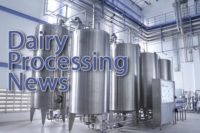Inside China
China's dairy farmers must increase production to meet demand for milk
Milk consumption in Chinese urban areas is 4.5 times higher than in rural areas. With the increasing urban population and the rapidly growing middle class, milk consumption is expected to further grow.

At the China Dairy Symposium in Beijing (from left ): Tyler Bramble, Alltech; Frank Delfino, Delfino Nutrition and Management; Mark Lyons, Alltech; Dan N. Waldner, Valley Nutrition; and Robert Erhard, Nestlé discussed issues such as consumer confidence and reducing feed costs.
Submitted by Alltech International
More than 240 global dairy industry leaders agree that milk production must keep up in China and, according to some U.S. dairy experts, adapting to the latest feed technologies may be the key to success.
Attendees at this year’s China Dairy Symposium, hosted by Alltech, discussed how the Chinese dairy market’s main challenge for the next 10 years will come from an increasing demand for milk, which will continue to outpace domestic supply. At the same time, they must meet the demands of more conscious consumers looking for high quality, safe dairy products.
By 2030, 70% of people in China will live in cities; milk and egg consumption compared to today will rise by more than 50% and consumers will demand healthier, safer and more nutritious food products.
“Milk consumption in Chinese urban areas is 4.5 times higher than in rural areas. With the increasing urban population and the rapidly growing middle class, milk consumption is expected to further grow,” said Dr. Mark Lyons, vice president of corporate affairs at Alltech. “Chinese dairy farmers will need to significantly increase their production efficiency to cope with this demand.”
Steve Maddox, chairman for the U.S. Dairy Promotion and Research Board, spoke of his long-term experience managing a highly successful dairy farm in Riverdale, Calif. “The best herd management comes from managers setting clear objectives, communicating on a weekly base and recording and monitoring results,” said Maddox.
He believes that the biggest challenge for dairy farmers is reducing feed costs, which can make up 65% of total production costs, while increasing milk production at the same time. During the panel, Maddox shared a testimonial about a California farmer who reformulated diets by lowering the nutrient content and adding alternative feed stuff such as Optigen, a sustained release, non-protein nitrogen source, in order to decrease the total cost of the ration.
Dr. Tyler Bramble, a dairy specialist from California, asked the audience to consider if it is possible to significantly reduce crude protein while at the same time maintaining milk production. Bramble introduced another California herd that had success. A 4,250-cow dairy that used DEMPTM, a dietary escape microbial protein product, in a reformulated diet, showed a relevant savings of .06 cents per head per day. The farmer saw an increase in milk production from 76.1 to 79.7 pounds and an increase in milk fat from 3.57% to 3.60% while keeping milk protein constant at 3.1%.
Looking for a reprint of this article?
From high-res PDFs to custom plaques, order your copy today!







